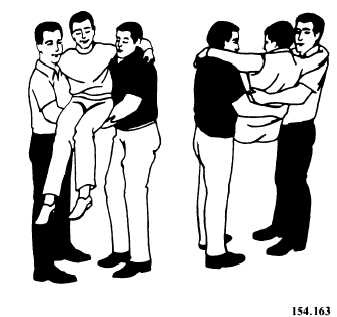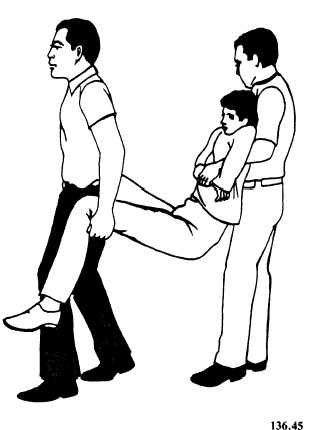The two-person arm carry, shown in figures 4-91 and 4-92, can be used in some cases to move an injured person. However, it should not be used to carry a person who has serious wounds or broken bones.

Figure 4-91.—Two-person arm carry.

Figure 4-92.—Two-person arm carry (alternate).
Another two-person carry that can be used in emergencies is shown in figure 4-93. Two rescuers position themselves beside the casualty, on the same side, one at the level of the chest and the other at the thighs. The rescuers interlock their adjacent arms as shown, while they support the victim at the shoulders and knees. In unison they lift the victim and roll his or her front toward theirs. This carry must not be used to move seriously injured persons.
TRANSPORTATION OF THE INJURED
Thus far in this chapter we have dealt with EMERGENCY methods used to move an injured person out of danger and into a position where first aid can be administered. As we have seen, these emergency rescue procedures often involve substantial risk to the casualty and should be used ONLY when clearly necessary.
Once you have rescued the casualty from the immediate danger, SLOW DOWN! From this point on, handle and transport the casualty with every regard for the injuries that have been sustained. In the excitement and confusion that almost always accompany an accident, you are likely to feel rushed, wanting to do everything rapidly. To a certain extent this is a reasonable feeling. Speed is essential in treating many injuries and in getting the casualty to a medical treatment facility, However, it is not reasonable to let yourself feel so hurried that you become careless and transport the victim in a way that will aggravate the injuries.
Emergency Vehicles, Equipment, and Supplies
In most peacetime emergency situations, some form of ambulance will be available to transport the victim to a medical treatment facility. Navy ambulances vary in size and shape from the old “gray ghost” to modern van and modular units. Although there are many differences in design and storage capacity, most Navy ambulances are equipped to meet the same basic emergency requirements. They contain equipment and supplies for emergency airway care, artificial ventilation, suction, oxygenation, hemorrhage control, fracture immobilization, shock control, blood pressure monitoring, and poisoning. They will
